2012 VOLKSWAGEN GOLF lock
[x] Cancel search: lockPage 267 of 516
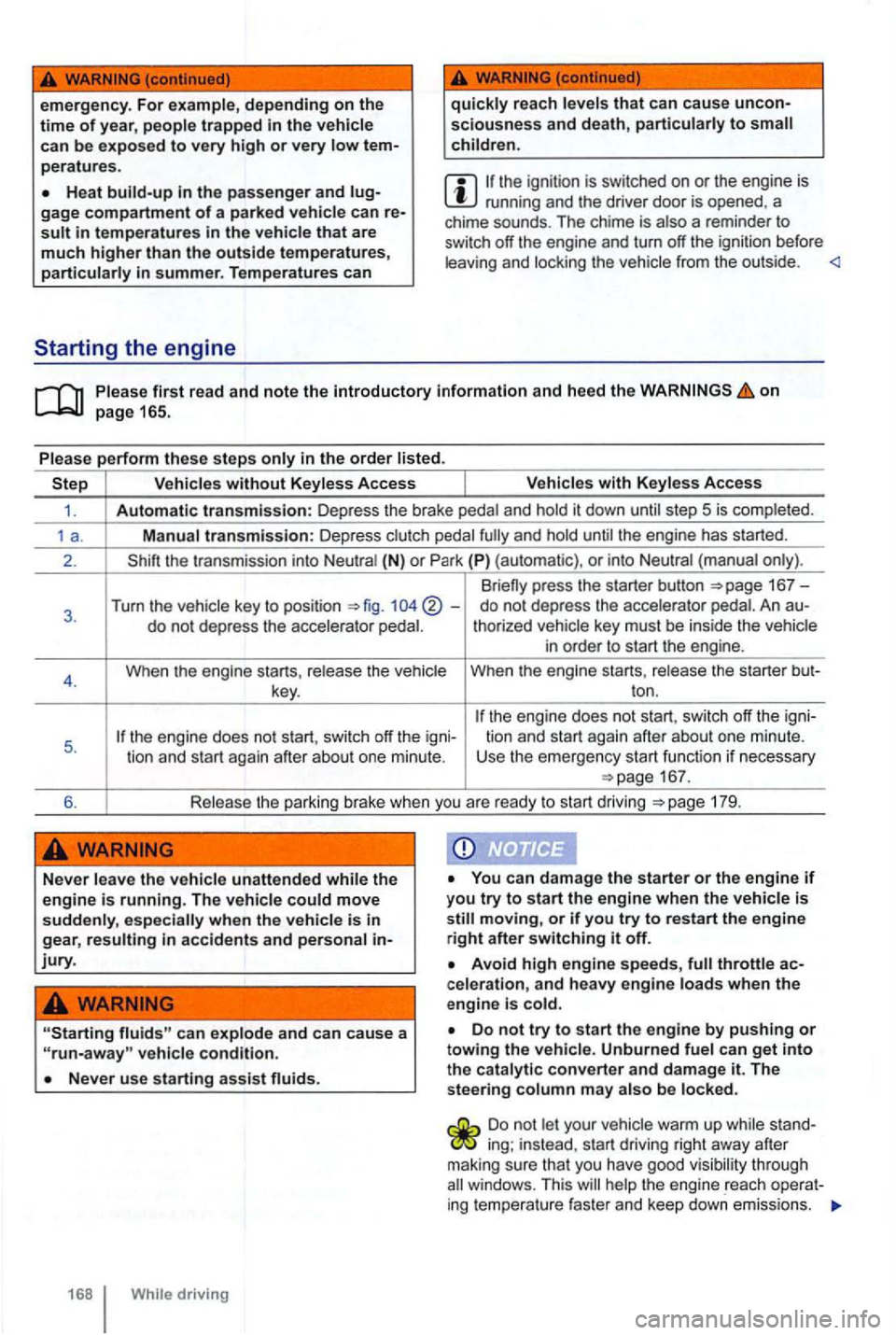
emergency. For example , depending on the time of year, people trapped in the vehicle
ca n be exposed to very high or very low tem
peratures .
Heat
quickly reach levels that can cause unconsciousness and death , particularly to
runn in g and the drive r doo r is op ened , a
chime sounds. T he chim e is also a re minde r to swi tch off the engine and turn off the ignition b efore
leavin g and locki ng th e veh icle from the out side .
(auto m atic) , or into Neut ral (manu a l o nly) .
167-
3. Turn the veh icle ke y to posi tion -do no t dep ress the accelerator p ed al. A n au-
do not depr ess the accele ra to r p ed al. t
h oriz ed vehicle key must be insi de t he ve h ic le
i n order to start th e engin e .
4 . Wh en the engi ne s ta rts, release th e v ehic le W
he n the e ng ine starts, release th e sta rte r but-
key . to n .
the engi ne does not start , swi tc h off the igni- tion an d s tart aga in after ab ou t o ne minute .
t io n and sta rt again after about one minut e. Use
the em ergenc y sta rt function if n ecessary 16 7 .
6 .
R elease the pa rking brake when you are ready to s tart dr iving 179 .
Never leave the vehicle unattended while the
engine is running. The vehicle could move suddenly, espec ially when the vehicle is in
gear, resulting in accidents and persona l in-jury.
can explode and can cause a vehicle condition.
Never use starting assist fluids .
moving, or if you try to restart the engine right after switching it off.
Avoid high engine speeds,
Do not le t your ve hicle warm up while stan ding; in stead . start drivi ng right awa y aft er making s ur e that yo u have good visib ilit y t hro ug h w indows. This help the e ngine reac h opera t
ing temp e rature faste r an d ke ep d own emissions.
Page 269 of 516
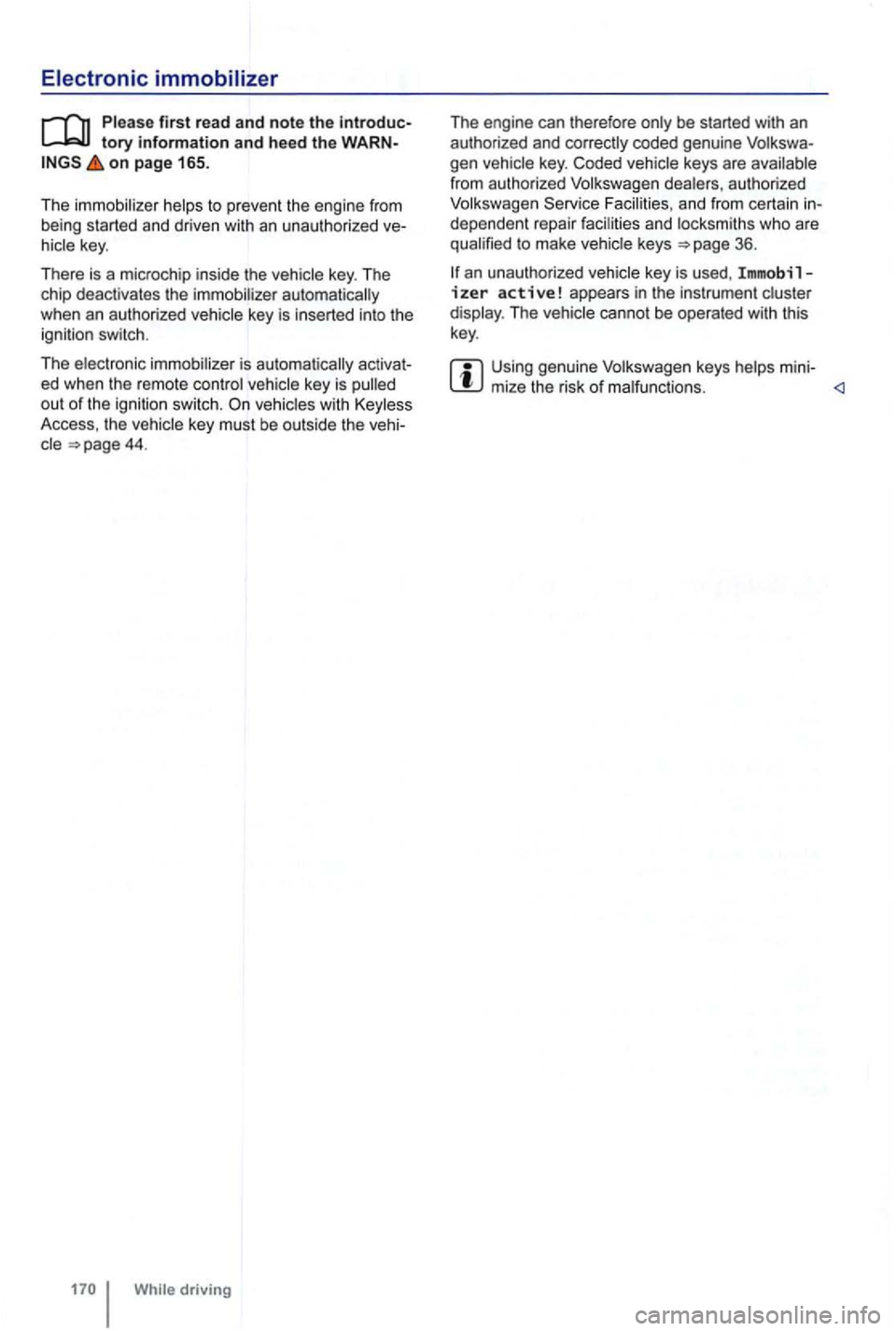
on page 165.
The immobilizer helps to pre ve
nt the engine fr om
being started and driven with an unauth orized
vehicles with Keyless
Access , th e vehicle key must be outside the
driving The
engine can therefore
dependent repair facilities and locksmiths who are to make vehicle keys 36.
an unauthorized vehicle key is used , Immobilizer active! appears in the instr ument cluste r
display . Th e
Using genuine mize the risk of malfun ctions .
Page 274 of 516
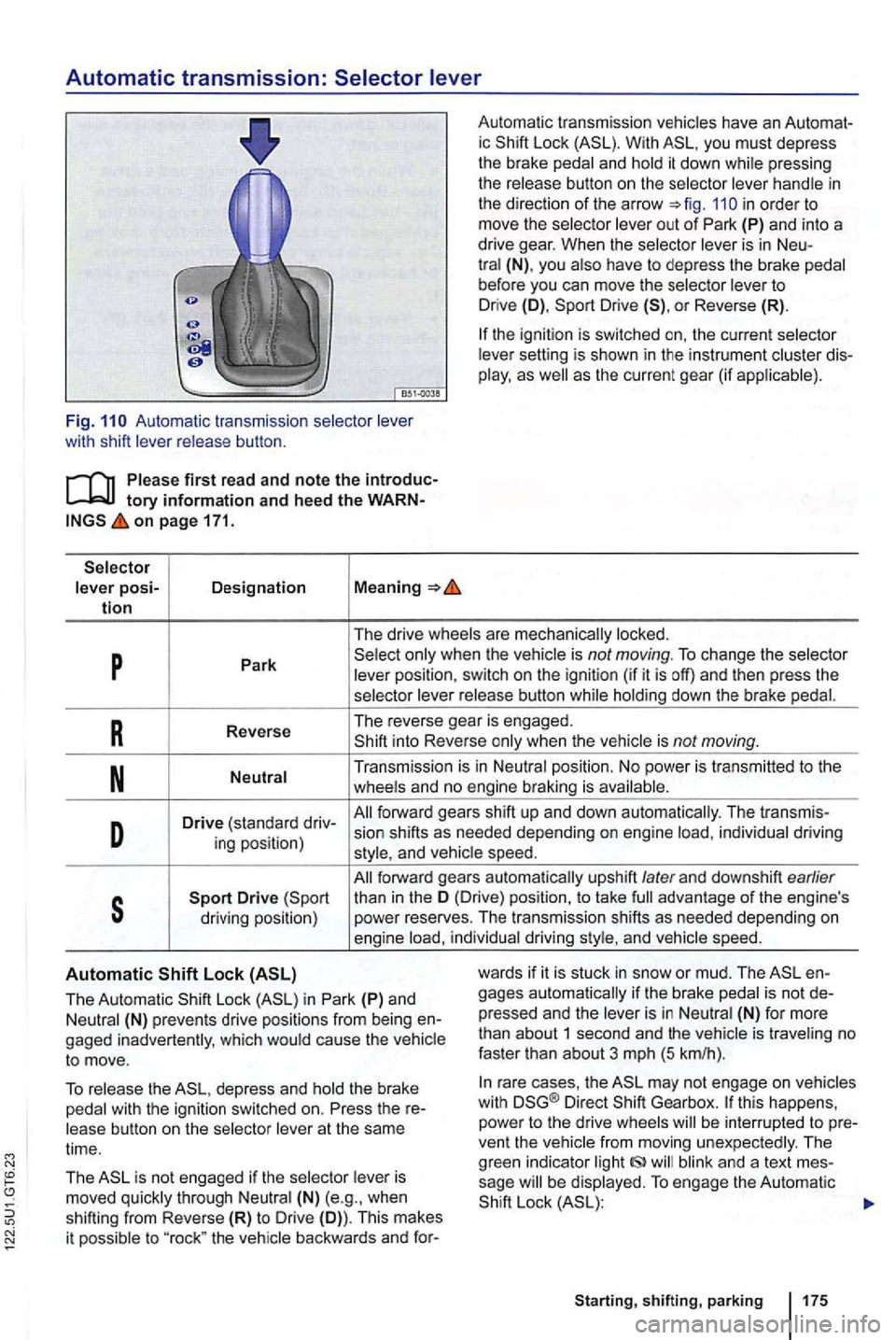
Automatic transmission:
Auto mati c transmissio n wit h sh ift
first re ad and note the tory information and heed the on page 171.
posi-Designation Meaning tion
Automa tic tra nsm issio n ic With you must depress
th e brake and pres sing
th e
in order to
move the
is in Neu-(N) , yo u before you can move the to Drive (D), Drive or Reverse (R).
sett ing is sho wn in the ins trument as the current gear (if
p Park is not moving. To change the
button
R Reverse The
re ver se gea r is en gage d. into Reverse when the
Transmis sion is in
D Drive (sta ndard dri v-fo rwa rd gears shift up and down auto m atica lly. The transmi s-
ing pos ition) sion
shifts as needed depending on engine individual driving and
forward gears automa tica lly upshift later and dow nshift earlier
s than in th e (Dri ve) position , to take advan ta ge of the engin e's
driving position) p
ower reserves. The tran smi ssion shift s as needed dependi ng on
e ng ine in divid ual driving and speed.
Automatic
The Automati c Lock in Park (P) and (N) prevents drive posit ions fro m b eing g aged inadvertentl y, w hich ca use the to move.
wards if it is stuc k in sno w or mud. The gages automa tically if th e brake pr esse d and the is in is traveling no
fast er than abo ut 3 mph (5 km/h ).
To the depress and the brake wit h th e ign ition switched on. Press the
(N) (e.g ., when shifting from Reverse (R) to Drive (D)). Th is mak es
i t possib le to "roc k" the
ra re cases , th e m ay not eng age on vehicles
w ith Direct Gea rbox. this happens,
power to th e drive ven t th e and a tex t sage Lock
sh ift ing , parking 175
Page 278 of 516
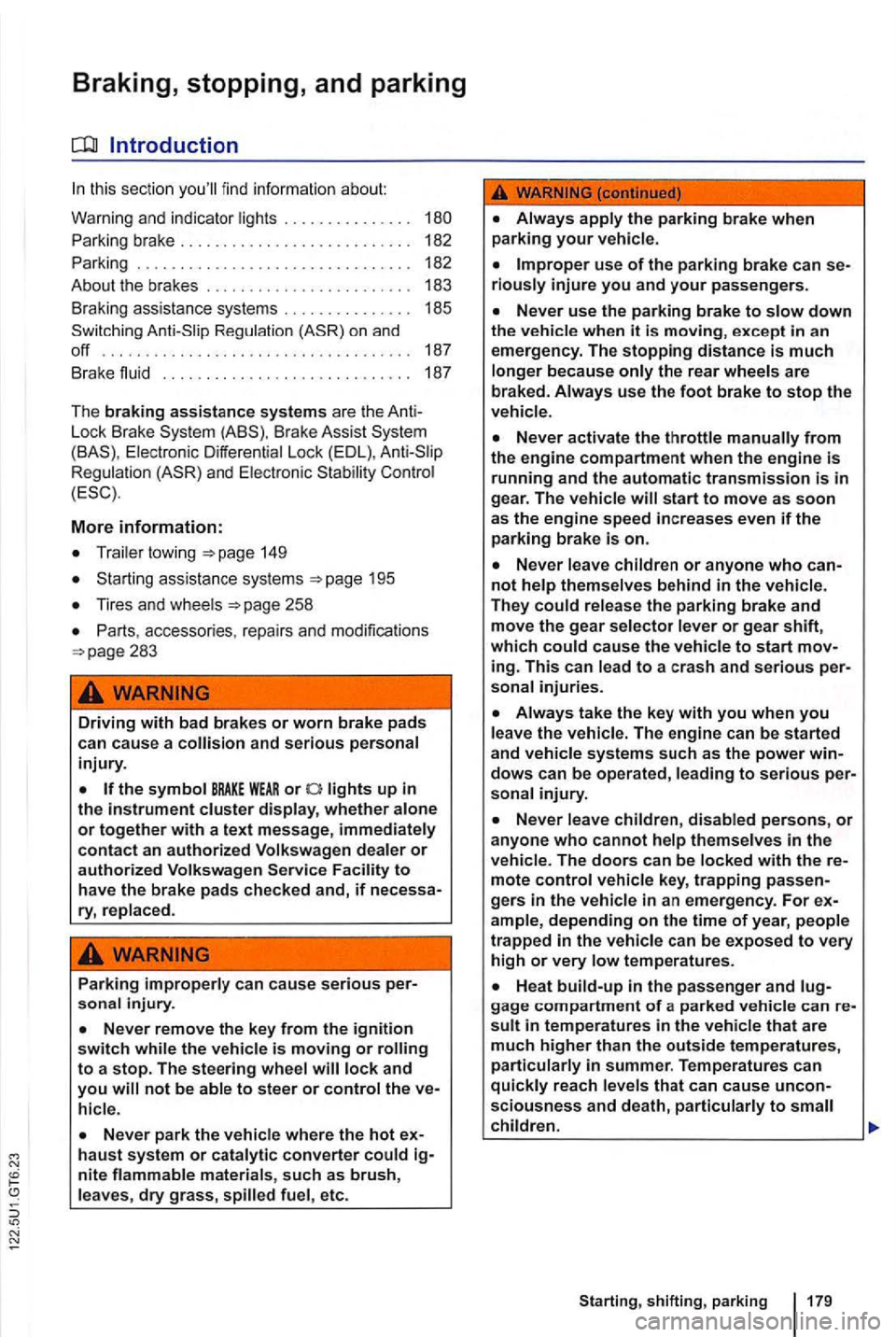
Braking, stopping, and parking
this sectio n
Parking brake . . . . . . . . . . . 182
P arking . . . . . . . . . . . . . .
. . . . . . . . . . . . . . . . . 182
About the brakes . . . . . . . . . . . . . . . . . . . . . . . . 183
Braking assistance systems
Switching
L ock Brake System (ABS) . Br ak e Assist System
(BAS ), Ele ctronic Differential Lock (EDL), R eg ulatio n (ASR) and Electronic C ontrol
(ESC).
More information:
Trai ler towi ng 149
Starting assistance systems 1 95
Tires and whee ls 258
Driving with bad brakes or worn brake pads can cause a and serious personal
injury.
lights up in the instrument cluster display, whether alone or together with a text message, immediately contact an authorized Volkswagen dealer or authorized Facility to have the brake pads checked and, if necessa
ry, replaced .
Parking improperly can cause serious sonal injury.
lock and you
haust system or catalytic converter could
fu el, etc.
riously injure you and your passengers.
sonal injury.
mote control vehicle key, trapping passengers in the vehicle in an emergency. For ample, depending on the time of year, people trapp ed in the vehicle can be exposed to very high or very low temperatures.
children.
Starting, shifting, parking 179
Page 280 of 516
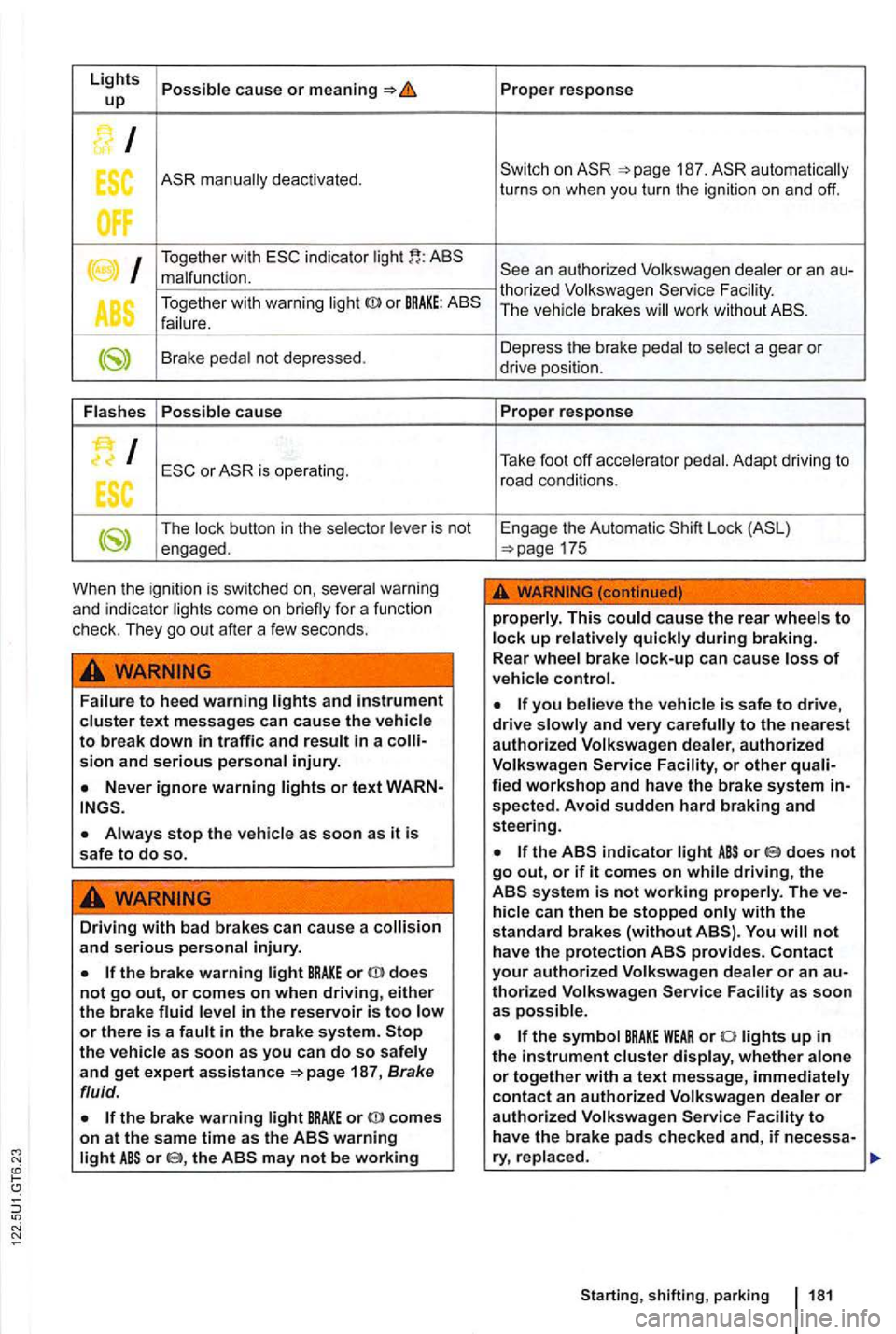
Lights cause or up
I
ES deactivated.
I Together with indicator malfunction .
T ogethe r with warning
or BRAKE:
Brake not dep ressed.
cause
I
The butt on in the is not
engaged .
When the ign ition is switch ed on,
text messages can cause the to break down in traffic and
or text WARN
stop the as soon as it is safe to do so.
Driving with bad brakes can cause a and serious
the brake warning BRAKE or does not go out, or comes on when driving, either the brake or there is a the as soon as you can do so and get expert assistance 187, Brake
fluid.
the brake warning comes on at the same time as the or the
187 . automatically
turns on when you turn the ignition on and off.
an authorized Volkswagen or an thorized Volkswage n The brake s work without
to
Adapt driving to
road conditions.
E ngage the Automatic
Lock
This up brake
you is safe to drive, drive and very authorized Volkswagen Service or other
spected. Avoid sudden hard braking and steering.
or does not go out, or if it comes on while driving, the system is not working can then be stopped with the
s tandard brakes (without not have the protection
thorized Volkswagen Service as soon as
Starting, shifting, parki ng 181
Page 281 of 516
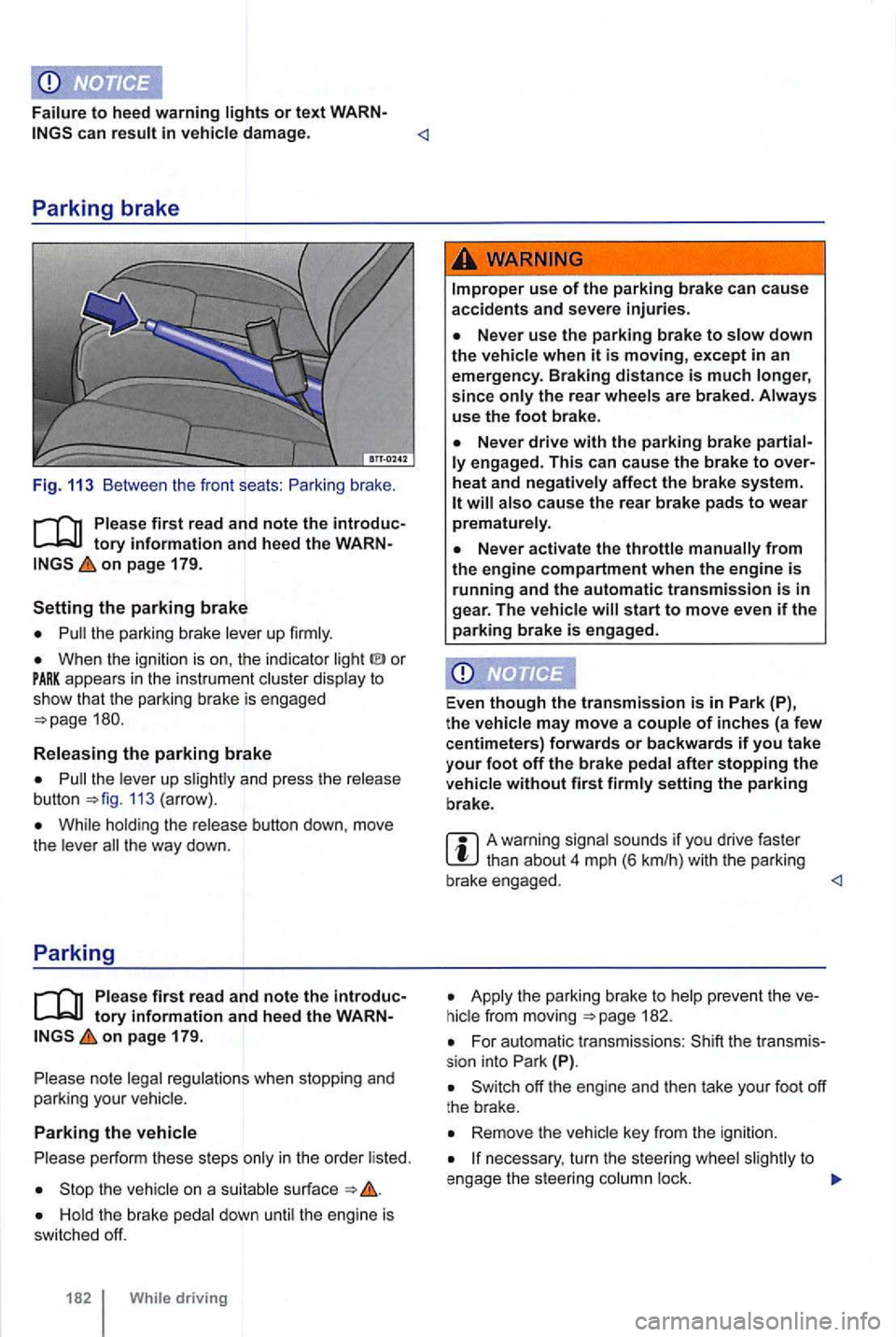
Failure to heed warning lights or t ex t WARN-can result in vehicle damage .
Fig. 113 Between the front seats :
on page 179.
the parking brake lever up firmly.
When the ignition is on , the indicator or appears in the instrume nt c luster display to show th at the park ing brake is engaged
the leve r up 113 (arrow) .
While hold ing the release button down, move
t h e lever t he way down.
Parking
Ple ase firs t r ea d and note the introductory info rm ation and heed the WARNon pa ge 179.
note legal regulations when stopping and
parking your vehicle.
Parking the vehicle
p erform these steps only in the order listed.
the vehicle on a suitab le surface
the rear wheels are braked . Always
use the foot bra ke.
engag ed. This c an cause the brak e to over
heat and neg ati vely affec t the b rak e sys te m .
start to move even if the parking brake is e ngag ed .
Even
though the tra nsmission is in P ark (P),
t h e vehi cle may move a couple of inche s (a fe w
c entimeters) forwards or backwards if you take
your f oot off the brake pedal after stopping the
ve hicl e without fir s t firmly setting the parking
b rake .
A warning signal sounds if you drive faster
Apply t he parking brake to 182.
For automatic transmissions : (P).
Remove the vehicle key from the igni tion.
necessary , turn the steer ing whee l to
e ngage the steer ing column lock.
Page 284 of 516

When th e front brakes are serviced , you
checked The best way to check for brake pad wear is to have your author-
Braking assistance systems
first read and note the introductory information and heed the WARNon pag e 179.
The and EDL braking assistance systems work
to improve road dynamics to of skidding and of when the engine is running . driving situations ,
you to get the
the
has of physics. not
may not be
or snow,
(r ides on a cushion of water instead of the road surface) , not be because contact with the pavement has been interrupted and the
as with difficult driving situations as it can at speeds. When towing a to if you were not towing a
to visiroad, traffic , and weather conditions . cannot override the in crease the trac tion , o r keep a
of keeping the and on the road ized
inspect the pads through the openings in the necessary, the can be taken
off for a more thorough inspection.
extreme maneuvers by using the driver's
s teeri ng inputs to
can provide any assistance, you may not experience the benefits of
and/or works together wi th the EDL, and XDL systems (see the time and cannot be switched off. certain situations when you need traction cannot be achieved, you can switch off by pressing the button on again when you no traction .
Anti-Lock Brake
to keep the to maintain the driver's to steer and the This means the is
down hard and
Do not "pump" the brake
the
notice a
cannot shorten the stopping distance
under all conditions. The stopping distance may even be for instance , when driving on gravor on snow covering an icy or pery surface.
Brake Assis t
can you press the brake very detects an emergency situation. brake system pres
sure , maximizing braking power and reducing the stopping distance. This way, and efficiently.
Page 285 of 516
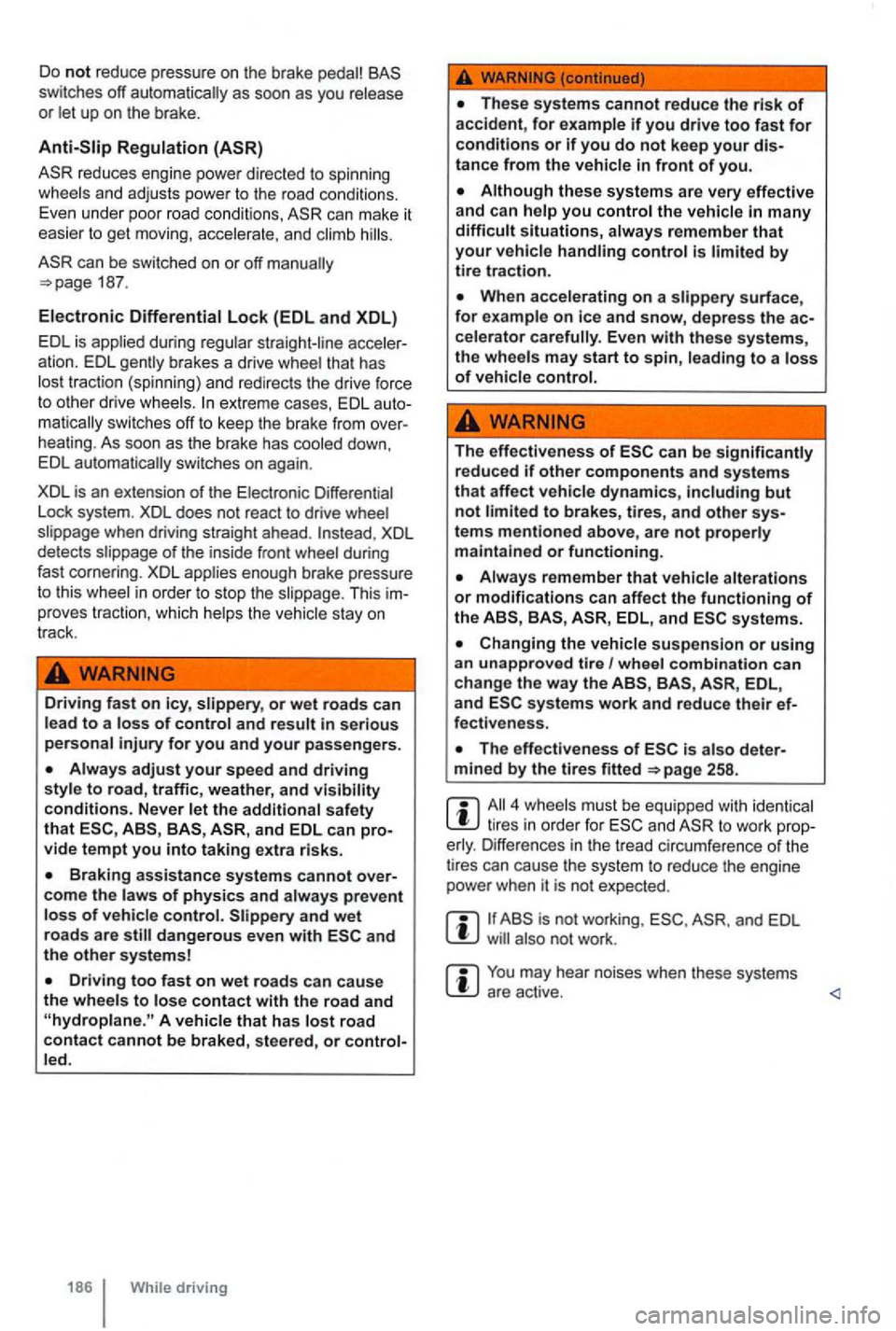
Do not reduce pressure on the brake
up on the brake.
Lock (EDL and XDL)
EDL is applied during regular straight -line
traction (spinning) and redirec ts the drive force to other drive wheels. extreme cases , EDL swi tches off to keep the brake from
switches on again .
XDL is an extension of the Electronic Differential
Lo ck sys tem . X DL does not react to drive wheel
s lippage when driving straight ahead .
XDL
detects slippage of the inside front wheel during
fast corne ring . X DL app lies enough brake pressure
to
this wheel in order to stop the slippage. This
Driving fast on icy, or wet roads can to a of control and result in serious persona l injury for you and your passengers.
Always adjust your speed and driving
style to roa d , traffic, weather, and visibility conditions. Never the additiona l sa fety that and EDL can
come the of physics and always prevent and wet
roads are dangero us eve n with and the o ther syste ms!
to A vehicle that has
1861 While driving
tance from the vehicle in front of you.
cele rator Even with these syste m s,
th e wheels may start to spin, le ading to a
The effectiveness of ca n be significantly reduced if other components and sys te m s that a ffect vehicle dynamic s, including but not limite d to bra kes , tires, and other te m s mention ed above , are not properly
maintained or fun ctioning.
Always remembe r that vehicle alterations or modifications can affect the functioning of the EDL, and systems.
Changing the vehicle su spension or using an unappro ved tire I wheel combination can
c han ge the way the EDL ,
and system s work and re duce their fectiveness .
The effectiveness of is als o
tires in orde r for and to work erly . Diff eren ces in the tread circumference of the
tir es can cause the system to r educ e the engine
p ower when it is not expected .
is not working, and EDL not work .
may hear noises when these systems are